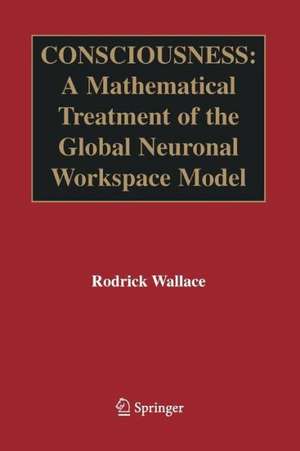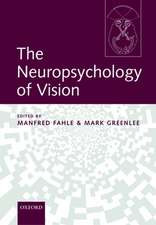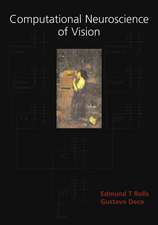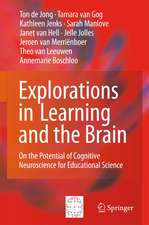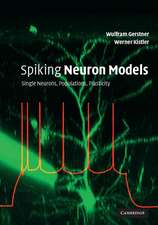Consciousness: A Mathematical Treatment of the Global Neuronal Workspace Model
Autor Rodrick Wallaceen Limba Engleză Paperback – 9 dec 2014
| Toate formatele și edițiile | Preț | Express |
|---|---|---|
| Paperback (1) | 378.71 lei 6-8 săpt. | |
| Springer Us – 9 dec 2014 | 378.71 lei 6-8 săpt. | |
| Hardback (1) | 385.84 lei 6-8 săpt. | |
| Springer Us – 14 apr 2005 | 385.84 lei 6-8 săpt. |
Preț: 378.71 lei
Nou
Puncte Express: 568
Preț estimativ în valută:
72.47€ • 77.49$ • 60.42£
72.47€ • 77.49$ • 60.42£
Carte tipărită la comandă
Livrare economică 17 aprilie-01 mai
Preluare comenzi: 021 569.72.76
Specificații
ISBN-13: 9781489995629
ISBN-10: 1489995625
Pagini: 132
Ilustrații: XIII, 116 p.
Dimensiuni: 155 x 235 x 7 mm
Greutate: 0.2 kg
Ediția:2005
Editura: Springer Us
Colecția Springer
Locul publicării:New York, NY, United States
ISBN-10: 1489995625
Pagini: 132
Ilustrații: XIII, 116 p.
Dimensiuni: 155 x 235 x 7 mm
Greutate: 0.2 kg
Ediția:2005
Editura: Springer Us
Colecția Springer
Locul publicării:New York, NY, United States
Public țintă
ResearchCuprins
Preface.- What is consciousness?- The Global Neuronal Workspace model. An introduction to information theory. The Shannon Coding Theorem. More heuristics: a 'tuning theorem'. The Shannon-McMillan Theorem. The Rate Distortion Theorem. Large deviations.- Fluctuations. The fundamental homology with statistical physics. Cognition as generalized language.- Theory. Two neural network examples. Interacting cognitive modules.- Representations. Language-on-a-network models. 'Biological' phase transitions. Universality class distribution. Universality class tuning. More on behavior far from the critical point. Extending the model. The simplest tunable retina. Tuning the visual retina. The torus and the sphere. Expanding the workspace. Energy efficiency and consciousness. Where does all this lead? Sociocultural context as selection pressure. Autocognitive developmental disorder. Toward a 'General Cognitive Model'. Evading the mereological fallacy.- References. Appendix on coarse graining.
Recenzii
From the reviews:
"To formulate a serious, clear-cut and transparent formal framework for cognitive neuroscience is a challenge … . I think that Wallace’s book presents an appreciable step in the right direction. … Beyond references that are necessary for basic elements of his work, the author has put together additional interesting reading material … . It is a book that can unfold its potential to well-educated readers with genuinely interdisciplinary ambitions … ." (Harald Atmanspacher, Acta Biotheoretica, Vol. 54, 2006)
"To formulate a serious, clear-cut and transparent formal framework for cognitive neuroscience is a challenge … . I think that Wallace’s book presents an appreciable step in the right direction. … Beyond references that are necessary for basic elements of his work, the author has put together additional interesting reading material … . It is a book that can unfold its potential to well-educated readers with genuinely interdisciplinary ambitions … ." (Harald Atmanspacher, Acta Biotheoretica, Vol. 54, 2006)
Textul de pe ultima copertă
"This book brings together the fundamental ideas of information theory and the statistical mechanics of phase transitions within the context of the neurosciences, culture, immunology and socio-psychological studies. Outlined is a program pertaining to a dynamic and semantic extension of current models for the global neuronal workspace as were previously introduced by Baars, Dretske and others. Topics include original applications of rate distortion and large deviations theory, biological renormalization, and retinal tuning as means towards understanding consciousness on the large scale. The overall treatment is concise, has been well thought out, and the mathematical details should be accessible to both students and researchers in the cognitive and life sciences."
- James Glazebrook Ph.D, Eastern Illinois University, USA
- James Glazebrook Ph.D, Eastern Illinois University, USA
Caracteristici
The first formal, comprehensive, and reasonably rigorous, mathematical treatment of the GNW. It is the only to include the effects of embedding contexts in a 'natural' manner, evading accusations of the mereological fallacy by the philosophers, and of irrelevance by the cultural psychologists Includes supplementary material: sn.pub/extras
